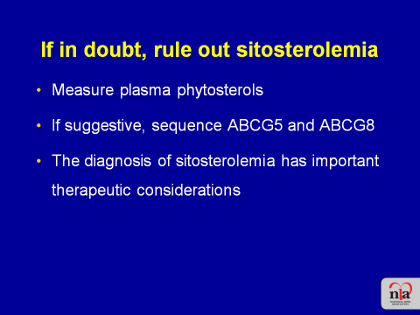Rader - Figure 8 - If in doubt, rule out sitosterolemia Text
Rader - Figure 8 - If in doubt, rule out sitosterolemia
In this author's opinion, the first rule when presented with a patient with severe hypercholesterolemia and an ambiguous pedigree is that if in doubt, rule out the diagnosis of sitosterolemia (Figure). If a person presents with severe hypercholesterolemia but a history fails to reveal a clear pattern of dominant inheritance of this within the family, then the physician should think as a lipidologist; this means that if sitosterolemia cannot be ruled out clinically or through family history, then this should be considered as the differential diagnosis.
Sitosterolemia is a recessively inherited disorder. This means that in order to rule it out, the screening tests are plasma phytosterols, sitosterol and campesterol. These tests are done from a clinical standpoint in a number of specialized referral labs in the United States. If a patient's results are normal, this basically rules out sitosterolemia as a diagnosis. On the other hand, if the results are abnormally high, this certainly suggests a diagnosis of sitosterolemia, and this is one of the areas where sequencing the ABCG5 and ABCG8 genes may be useful to definitively diagnose sitosterolemia.
It is important to correctly diagnose sitosterolemia because, in contrast to most of the other causes of severe hypercholesterolemia, a diagnosis of sitosterolemia has important therapeutic considerations for the clinical approach to this type of patient.
